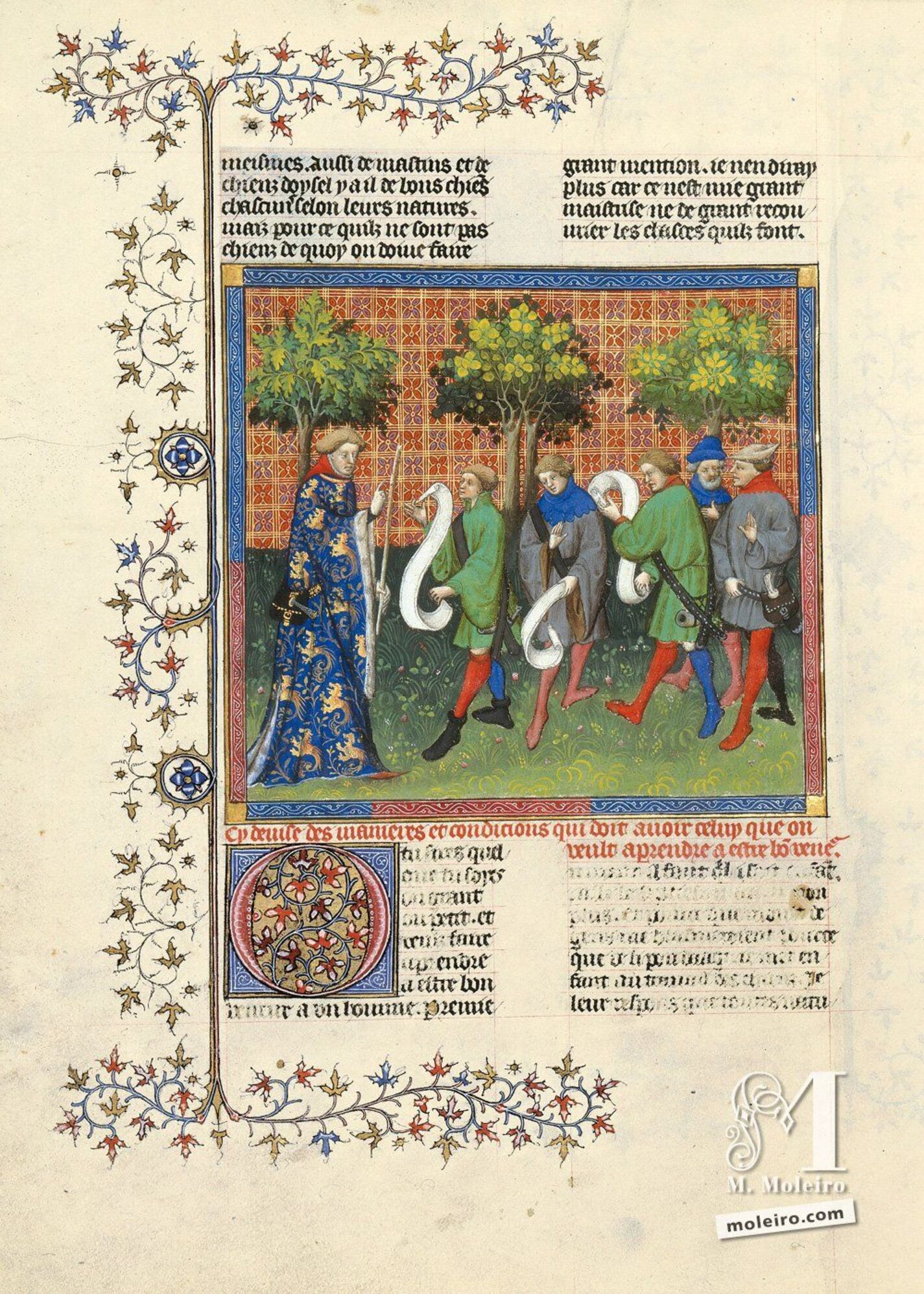After having compiled a catalogue of animals to hunt and the dogs which can be used for this practice, Fébus introduces a new section of his book, without it actually materialising. This scene is very important to the history of the transmission of the Count of Foix´s work. Effectively, it acts as proof that the St. Petersburg manuscript, here folio 37r, was the model for the Paris and New York manuscripts, and not the grisaille one which stayed in his possession. The master of the workshop giving instructions to his three young apprentices stands on the left in the St. Petersburg manuscript, as well as in those of Paris and New York, but sits in the centre of the image of the grisaille volume (folio 40r). The miniature in our manuscript stayed faithful to its model. The master of the workshop, bareheaded with his cane in his left hand, is dressed in a long deep blue pelisse embroidered with gold lions. He addresses his apprentices, holding in his hands long phylacteries without any inscription. The apprentices which appear in the two manuscripts commissioned by the Duke of Bourgogne are already adults, while in Fébus´ work they are still children. The grisaille volume gives us the meaning of the ribbons brandished by the apprentices. They bear the names of his favourite hounds: Lorete, Fricaut, Clabaud, Fretel, Vilhaut and Hurtaut. We understand, then, that the phylacteries in the manuscript dedicated to Philip the Bold were left blank, so that they could be inscribed with the names of the Duke of Burgundy´s favourite hounds. For the same reason, John the Fearless asked that the phylacteries in the two manuscripts he hoped to offer to two great princes were also left blank, so that they could be filled with the names of the dedicatee´s dogs. The faithfulness of the Paris manuscript to its model is visible even in minute details: the three trees on the red-hued diapered background and the master of the workshop´s clothes, blue with a red collar. The only differences are the names and ages of the apprentices, and especially the presence of the three older phylactery-holders at the back, talking amongst themselves or discussing the master´s speech.
Yves Christe,
Université de Genève

After having compiled a catalogue of animals to hunt and the dogs which can be used for this practice, Fébus introduces a new section of his book, without it actually materialising. This scene is very important to the history of the transmission of the Count of Foix´s work. Effectively, it acts as proof that the St. Petersburg manuscript, here folio 37r, was the model for the Paris and New York manuscripts, and not the grisaille one which stayed in his possession. The master of the workshop giving instructions to his three young apprentices stands on the left in the St. Petersburg manuscript, as well as in those of Paris and New York, but sits in the centre of the image of the grisaille volume (folio 40r). The miniature in our manuscript stayed faithful to its model. The master of the workshop, bareheaded with his cane in his left hand, is dressed in a long deep blue pelisse embroidered with gold lions. He addresses his apprentices, holding in his hands long phylacteries without any inscription. The apprentices which appear in the two manuscripts commissioned by the Duke of Bourgogne are already adults, while in Fébus´ work they are still children. The grisaille volume gives us the meaning of the ribbons brandished by the apprentices. They bear the names of his favourite hounds: Lorete, Fricaut, Clabaud, Fretel, Vilhaut and Hurtaut. We understand, then, that the phylacteries in the manuscript dedicated to Philip the Bold were left blank, so that they could be inscribed with the names of the Duke of Burgundy´s favourite hounds. For the same reason, John the Fearless asked that the phylacteries in the two manuscripts he hoped to offer to two great princes were also left blank, so that they could be filled with the names of the dedicatee´s dogs. The faithfulness of the Paris manuscript to its model is visible even in minute details: the three trees on the red-hued diapered background and the master of the workshop´s clothes, blue with a red collar. The only differences are the names and ages of the apprentices, and especially the presence of the three older phylactery-holders at the back, talking amongst themselves or discussing the master´s speech.
Yves Christe,
Université de Genève